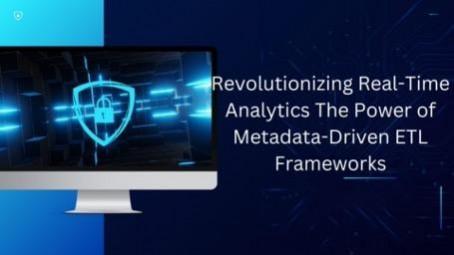
The landscape of data analytics is evolving, and metadata-driven Extract, Transform, Load (ETL) frameworks are at the forefront of this transformation. Sudhakar Reddy Vyza explores how these frameworks are reshaping real-time analytics, providing businesses with scalable, automated, and efficient data processing solutions. This article delves into the key innovations of metadata-driven ETL and their impact on enterprise data management.
Addressing the Challenges of Traditional ETL
Real-time data processing demands efficiency, accuracy, and scalability, but traditional ETL systems struggle with these requirements. Legacy systems rely heavily on manual intervention, making them less adaptable to dynamic data environments. Metadata-driven ETL frameworks solve these issues by introducing a structured approach to automation, reducing latency, and improving data consistency across multiple sources.
The Role of Metadata in Automation
One of the defining features of metadata-driven ETL frameworks is their ability to separate business logic from technical implementation. This is achieved through a centralized metadata repository, which houses transformation rules, data mappings, and pipeline configurations. By leveraging metadata, organizations can dynamically adjust their data pipelines without requiring extensive re-engineering efforts.
Enhancing Data Quality and Governance
Maintaining high data quality is critical for businesses, particularly in industries that rely on precise analytics. Metadata-driven ETL frameworks integrate automated validation rules, anomaly detection, and real-time monitoring to ensure data integrity. This proactive approach helps organizations maintain compliance while minimizing errors in reporting and decision-making processes.
Dynamic Orchestration for Real-Time Processing
In traditional ETL architectures, workflow execution is often static, limiting adaptability to real-time data flows. Metadata-driven frameworks introduce dynamic orchestration mechanisms, which adjust processing sequences based on workload fluctuations. This ensures optimal resource utilization and seamless scalability, making real-time analytics more efficient and responsive to business needs.
These adaptive frameworks also enable intelligent error handling and automated recovery processes, reducing system downtime and maintaining data integrity throughout the pipeline. Custom monitoring dashboards provide real-time visibility into workflow performance.
Transformational Impact Across Industries
Industries handling vast amounts of data, such as financial services, e-commerce, and healthcare, are seeing significant benefits from adopting metadata-driven ETL frameworks. These systems streamline data integration processes, enhance fraud detection capabilities, and optimize personalized user experiences. The automation of complex data workflows allows businesses to extract actionable insights faster, improving overall operational efficiency.
Overcoming Scalability Challenges
While metadata-driven ETL frameworks offer numerous advantages, scaling them in ultra-large-scale environments presents challenges. Managing vast metadata repositories and ensuring seamless synchronization across distributed systems require advanced strategies, such as intelligent metadata partitioning and automated resource allocation. Future developments in metadata compression and distributed processing could further enhance scalability.
Strengthening Security in Data Processing
Security is a crucial consideration in any data-driven system, and metadata-driven ETL frameworks are no exception. Ensuring secure access to metadata repositories, implementing robust authentication protocols, and integrating encryption techniques are essential steps in mitigating security risks. As businesses continue to rely on real-time data analytics, developing secure and resilient ETL architectures will be paramount.
The Future of Metadata-Driven ETL
Emerging technologies like artificial intelligence, machine learning, and blockchain are set to further enhance metadata-driven ETL frameworks. AI-driven automation could optimize metadata management, while blockchain can provide enhanced security and transparency in data lineage tracking. As organizations strive for more agile and intelligent data processing solutions, these frameworks will continue to play a pivotal role in shaping the future of real-time analytics.
In conclusion, the adoption of metadata-driven ETL frameworks marks a significant advancement in real-time data processing. As highlighted by Sudhakar Reddy Vyza, these frameworks automate and streamline data integration, empowering businesses to boost efficiency, enhance data quality, and maintain agility in an increasingly data-driven world. Embracing this approach ensures organizations can adapt to evolving data demands while optimizing their analytics and decision-making capabilities.

















